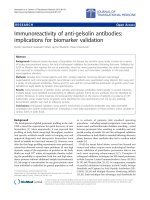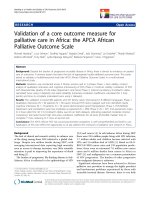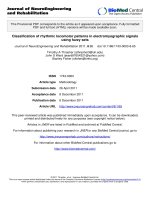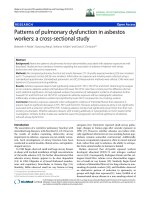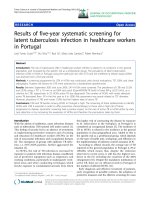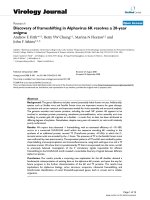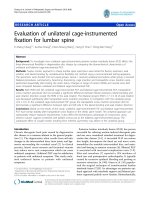Báo cáo hóa học: " Synthesis of silicalite-poly(furfuryl alcohol) composite membranes for oxygen enrichment from air" docx
Bạn đang xem bản rút gọn của tài liệu. Xem và tải ngay bản đầy đủ của tài liệu tại đây (911.98 KB, 9 trang )
NANO EXPRESS Open Access
Synthesis of silicalite-poly(furfuryl alcohol)
composite membranes for oxygen enrichment
from air
Li He
1
, Dan Li
1
, Kun Wang
1
, Akkihebbal K Suresh
2
, Jayesh Bellare
2
, Tam Sridhar
1
and Huanting Wang
1*
Abstract
Silicalite-poly(furfuryl alcohol) [PFA] composite membranes were prepared by solution casting of silicalite-furfuryl
alcohol [FA] suspension on a porous polysulfone substrate and subsequent in situ polymerization of FA. X-ray
diffraction, nitrogen sorption, thermogravimetric analysis, scanning electron microscopy, and energy-dispersive X-
ray spectroscopy were used to characterize silicalite nanocrystals and silicalite-PFA composite membranes. The
silicalite-PFA composite membrane with 20 wt.% silicalite loading exhibits good oxygen/nitrogen selectivity (4.15)
and high oxygen permeability (1,132.6 Barrers) at 50°C. Silicalite-PFA composite membranes are promising for the
production of oxygen-enriched air for various applications.
Keywords: poly(furfuryl alcohol), silicalite, composite membrane, air separation
Introduction
Oxygen-enriched air can be widely used in chemical
industries, fermentation, biological digestion processes,
and medical purposes [1-3]. For example, combustion
with oxygen-enriched air can substantially reduce fuel
consumption and improve energy efficiency, thereby
lowering CO
2
emission [2].
The cryogenic fractionation technology is commonly
used to produce oxygen-enriched air with an oxygen
purity of 99 vol.%. Pressure swing adsorption can yield
95 to 97 vol.% oxygen-enriched air [4]. The membrane
technology has also been researched for oxygen separa-
tion from air. Over the past decades, polymeric gas
separation membranes have attracted much attention,
becoming one of the fastest growing branches of mem-
brane technology. This is because polymeric membranes
tend to be relatively inexpensive and can be easily fabri-
cated into hollow fibers or spiral-wound modules [5,6].
Some polymeric membranes such as silicone rubber,
polyphenylene oxide, and cellulose triacetate have
already been studied for oxygen enrichment [2,3,7].
However, because the molecular dimensions of O
2
(3.46
Å) and N
2
(3.64 Å) are close, producing p ure oxygen is
rather difficult as some nitrogen always permeates
through the membrane [5]. The separation properties of
existing polymeric membranes are still restricted by the
trade-off trend between gas permeability and selectivity
which was suggested by Robson [8]. Additional limita-
tion of the polymeric membrane is that at elevated tem-
peratures, the performance of the membrane will lose
because of the segmental flexibility [9]. Therefore, the
separation membranes with high O
2
/N
2
selectivity and
high flux are required to be competitive with other
technologies.
Inorganic molecular sieves (such as zeolites) exhibit
good chemical and thermal stabilities and high gas flux
and selectivity, but the fabrication of defect-free molecu-
lar sieve membranes remains a challenge. In recent dec-
ades, there has been significant interest in the
development of synthesis methods of pinhole-free,
mechanicall y stable, and inorganic-organic hybrid mem-
branes to combine the advantages of both inorganic and
organic membranes. Such kind of membrane is known
as mixed matrix (or composite) membranes. Desirable
composite membranes consist of well-dispersed particles
without interfacial incompatibility and defects between
the inorganic material and the polymer. Therefore, care-
ful selection of a pair of polymer and inorganic material
* Correspondence:
1
Department of Chemical Engineering, Monash University, Clayton, Victoria,
3800, Australia
Full list of author information is available at the end of the article
He et al. Nanoscale Research Letters 2011, 6:637
/>© 2011 He et al; licensee Springer. This is an Open Access article distributed under the terms of the Creative Commons Attribution
License ( , which permits unrestricted use, distribution, and reproduction in any medium,
provided the original work is properly cited.
is very important. Polysulfones, polyarylates, polycarbo-
nates, poly(arylethers), poly(arylketones), and polyimides
are frequently used in industrial polymeric membrane
gas separations. The commonly used inorganic materials
include carbon molecular sieves, zeolites, mesoporous
materials, activated carbons, carbon nanotubes, and
metal-organic framework [10].
In the present work, we attempt to develop zeolite-
polymer composite membranes for oxygen production
from air. In particular, poly(furfuryl alcohol) [PFA] is
chosen as the polymer matrix, and silicalite, as the
molecular sieve additive. In the work previously con-
ducted by one of the authors (Wang et al.), poly(furfuryl
alcohol) was used to prepare a zeolite 4A polyfurfuryl
alcohol nanocomposite membrane by vapor depositio n
polymerization of furfuryl alcohol [FA] [11,12]. This
composite membrane showed an O
2
/N
2
selectivity as
high as 8.2 and an oxygen permeance of 1.5 × 10
-9
mol·m
-2
·s
-1
·Pa
-1
.Toimproveoxygenflux,silicaliteis
used in the present study because it has a larger pore
size than the zeolite 4A. Silicalite is a pure silica MFI-
type zeolite, which is composed of a uniform molecular-
sized pore system with straight channels in the b-direc-
tion (5.4 Å × 5.6 Å) and sinusoidal channels in the a-
direction (5.1Å × 5.5 Å) [13,14].
Experimental details
Materials
One molar tetrapropylammonium hydroxide [TPAOH]
aqueous solution and tetraethyl orthosilicate [TEOS]
(99%), acrylamide [AM], N,N’-methylenebisacrylamide
[MBAM], and FA (98%) were purchased from Sigma-
Aldrich Corporation (Sydney, Victoria, Australia). A
polysulfone ultrafiltration membrane (MWCO 30,000)
was purchased from Sterlitech (GE Osmonics, Minne-
tonka, MN, USA) and used as the support.
Preparation of silicalite nanocrystals
Silicalite nanocrystals were synthesized according to the
previously published procedures [15]. In a typical synth-
esis, silicalite nanocrystals were synthesized by hydro-
thermal synthesis from a clear solution with a molar
composition of 1 TPAOH:4.8 SiO
2
:44 H
2
O. The synth-
esis solution was prepared in a 250-mL polypropylene
bottle. First, 20 g of 1 M TPAOH solution was added
dropwise into 20 g of TEOS under vigorous stirring.
Strong magnetic stirring was maintained for 3 h. The
solution was then heated in an oven at 80°C for 5 to 6
days for crystallization, resulting in a milky silicalite sus-
pension. The solid product contained in the colloidal
suspension was recovered by a repeated cycle of centri-
fugation with deionized water and ultrasonic redisper-
sion in water until pH < 8. An organic polymer network
was prepared from water soluble organic monomers,
AM and MBAM, and the initiator (NH
4
)
2
S
2
O
8
as a tem-
porary barrier during calcination and carbonization to
obtain highly redispersible template-free silicalite nano-
crystals. Typically, 1.0 g of AM, 0.1 mg MBAM, and 25
mg of (NH
4
)
2
S
2
O
8
were added under stirring into 10 g
of silicalite colloidal suspension with 5 wt.% solid load-
ing. After the monomers were dissolved, the mixture
was ultrasonicat ed to ensure co mplete dispersion of sili-
calite nanocrystals for half an hour. The aqueous solu-
tion was then heated at 50°C for 30 min to be
polymerized into an elastic hydrogel. This silicalite
hydrogel polymer composite was dried at 80°C over-
night. After drying, it was carbonized under nitrogen at
550°C for 2 h (heating rate, 2°C min
-1
)andthencal-
cined at 550°C for 3 h under air.
Preparation of silicalite/PFA composite membranes
Both plain PFA and silicalite-PFA composite membranes
were hand-cast on commercial polysulfone ultrafiltration
membranes. [16] A 25 mm × 70 mm polysulfone u ltra-
filtration membrane was fixed on the top of a micro-
scopeglassslideusingatapetopreventthemembrane
from rolling up and solution penetration through the
edges. Then, an aqueous solution prepared by mixing 10
g of FA and 0.04 g of sulfuric acid with 10 g of ethanol
was cast on the polysulfone membrane substrate for 5
min at room temperature. The coated support was then
heated at 80°C overnight for FA polymerization. Silica-
lite-PFA nanocomposite membranes were made using
the same procedures, except that a given amount of
template-free silicalite nanocrystals was dispersed in the
FA ethanol solution which was ultrasonicated for 30
min at room temperature. The resulting silicalite-FA
ethanol suspension was immediate ly mixed with su lfuric
acid under magnetic stirring for 2 min and then coated
on the polysulfone membrane substrate for 5 min at
room temperature. The c oated support was heated at
80°C overnight. The resultant composite membranes are
referred to as 1-Sil-PFA, 10-Sil-PFA, 20-Sil-PFA, and
30-Sil-PFA, corresponding to silicalite loadings of 1%
(w/w), 10% (w/w), 20% (w/w), and 30% (w/w)inPFA
solution, respectively.
Characterization
X-ray diffraction [XRD] patterns were recorded on a
Philips PW1140/90 diffractometer (PANalytical B.V.,
Almelo, The Netherlands) with Cu Ka radiation (25 mA
and 40 kV) at a scan rate of 2°/min with a step size of
0.02°. Nitrogen adsorption-desorpti on experiment was
performedat77Kandatroomtemperaturewitha
Micrometritics ASAP 2020MC analyzer (Micromeritics
Instrument Co., Norcross, GA, USA). To evaluate the
thermal stability of the PFA, thermogravimetric analysis
[TGA] was conducted using a thermogravimetric
He et al. Nanoscale Research Letters 2011, 6:637
/>Page 2 of 9
analyzer (PerkinElmer, Waltham, MA, USA) in the tem-
perat ure range of 20°C to 700°C under nitrogen gas and
a heating rate of 5°C/min. All scanning electron micro-
scopy [SEM] images were taken with a FEG-7001F
microscope (JEOL, Ltd., Akishima, Tokyo, Japan) oper-
ated at an accelerating voltage of 15 kV. Elemental ana-
lysis of samples was determined by energy dispersive X-
ray spectroscopy [EDXS] on the FEG-7001F microscope.
Gas separation
The PFA composite membrane samples were dried at
80°C overnight before the gas permeation test. The sin-
gle gas permeation of membranes was measured using
the pressure rise method. The feed gas was supplied at
room temperature and atmospheric pressure. The
perme ate rate was determined by isolating the permeate
volume from the vacuum supply and subsequently mon-
itoring the pressure change in the permeate side. The
effective membrane area was 0.95 cm
2
.Thepressure
rise was recorded by a MKS 628D Bar atron transducer
(MKS Instruments Inc., Wilmington, MA, USA). Mem-
brane permeability, P
i
(Barrer; 1 Barrer = 10
-10
cm
3
(STP)·cm·cm
-2
·s
-1
·cmHg
-1
), was defined as [1,17-19]
P
i
=
dN
i
p
i
A
,
where N
i
(mol·s
-1
) is the permeate flow rate of compo-
nent gas i, Δp
i
(in Pascals) is the transmembrane pres-
sure difference of i,andA (in square centimeters) is the
membrane area.
The ideal selectivity a
ij
was calculated from the rela-
tion between the permeance of pure i and j gases [1,17]:
α
ij
=
P
i
P
j
.
The apparent activation energy E
p
(in kiloJoule per mole)
was analyzed according to the Arrh enius equation [ 20-23]:
P = P
o
exp
−E
p
RT
,
where P is the permeabi lity (in Barrers), P
o
is the pre-
experiential factor, T is the absolute temperature (in
Kelvin), and R is the gas constant (8.3143 J·mol
-1
·k
-1
).
The volume fraction of oxygen X
02
in the product gas
from air is shown in the following equation [24]:
X
O2
=
1
2
⎧
⎨
⎩
(
α − 1
)(
0.21 + ϕ
)
+1
(
α − 1
)
ϕ
−
(
α − 1
)(
0.21 + ϕ
)
+1
(
α − 1
)
ϕ
2
−
(
4
)(
0.21
)
r
(
α − 1
)
ϕ
⎫
⎬
⎭
,
where a is the selectivity of O
2
to N
2
, is the ratio of
product to feed gas pressures, and 0.21 is the fraction of
oxygen in the feed air.
Results and discussion
Silicalite nanocrystals and silicalite-PFA membranes
N
2
adsorption measurement shows that silicalite nano-
crystalshaveaBETsurfaceareaof404m
2
/g and a t-
plot microspore volume of 0.12 cm
3
/g, which are close
to the reported values for crystalline nanosilicalite
[15,25]. The SEM images of silicalite nanocrystals shown
in Figure 1 rev eal uniform spherica l nanopa rticles and a
narrow particle size distribution ranging from 60 nm to
100 nm.
Figure 2 shows XRD patterns of the silicalite, PFA
composite membrane, and Sil-PFA composite mem-
brane with different silicalite loadings (10 wt.% and 20
wt.%). The diffraction peaks at 2θ = 21.58, 24.13, 30.10,
36.38, 40.92, and 44.18 arise from the substrate that
consists of a polysulfone membrane supported on a
polyethylene non-woven polyethylene fabric. These
peaks are mainly from the polyethylene fabric [26]. For
silicalite nanocrystals, there are two peaks at 2θ =7.8
and 2θ = 8.68. When the loading of silicalite nanocrys-
tals in Sil-PFA composite membranes increases, the
intensities of these two peaks increase. This confirms
the presence of silicalite nanoparticles in the PFA
polymer.
Thermogravimetric analysis of the silicalite nanocrys-
tals, PFA, and silicalite-PFA composite membrane (Fig-
ure 3) shows that the silicalite crystals remain in the
testing temperature under N
2
, except a slight mass loss
(ca. 2.9%) at 100°C to 200°C which is attributed to water
desorption. However, under flowing nitrogen, the PFA
composite membrane loses ca. 8.9% of its mass in the
temperature range from 25°C to 200°C, corresponding
to the loss of absorbed water. In the temperature range
of 200°C to 450°C, there is a 25.7% mass loss. From
450°C to 700°C, a further 46.4% mass loss is observed
due to the decomposition of the PFA membrane. The
mass losses of Sil-PFA composite membranes are much
slower than those of the PFA composite membrane.
The total final mass losses are 81.0%, 79.8%, and 72.1%
for pure PFA, 1% Sil-PFA, and 20% Sil-PFA composite
membranes, respectively. The mass losses of the sup-
ported PFA and silicalite-PFA composite membranes are
much smaller than those of the pure PFA. This result
indicates that the Sil-PFA composite membrane with
high silicalite loading exhibits higher thermal stability.
Figure 4 shows SEM images of the cross-sections of
the pure PFA membrane and 10% Sil-PFA composite
membrane. The thicknesses of the active PFA layer and
silicalite-PFA are around 1.5 to 2.0 μm. The cross-sec-
tion morphology reveals the strong adhesion among
PFA and the silicalite nanoparticles and the substrate,
and that the silicalite particles are well dispersed in the
PFA. Figure 5 shows SEM images of the top surfaces of
He et al. Nanoscale Research Letters 2011, 6:637
/>Page 3 of 9
the pure PFA composite membrane and 1 0% Sil-PFA,
20% Sil-PFA and 30% Sil-PFA composite membranes.
The PFA membrane exhibits a smooth surface (Figure
5a), which is similar to that reported previously [27].
Uniform dispersion of silicalite nanocrystals throughout
the Sil-PFA composite membrane surfaces was clearly
observed (Figure 5b, c). However, as the concentration
of silicalite increases to 30% (w/w), the agglomeration of
silicalite nanoparticles becomes evident (Figure 5d).
The presence of silicalite nanocrystals was also con-
firmed by EDX. In Figure 6, the carbo n, oxygen, silicon,
and sulfur peaks in EDX spectra arise from polysulfone-
supported PFA composite membranes, and there is no
silicon peak in the plain PFA composite membranes.
Then, the Si peak appears at approximately 1.74 keV in
1% Sil-PFA composite membranes. As the loading of
silicalite increases, the intensity of silicon peak increases.
This clearly indicates the presence of silicalite nanocrys-
tals in the Sil-PFA composite membranes.
Gas separation properties
Table 1 summar izes the permeability values of single N
2
and O
2
gases and the O
2
/N
2
ideal selectivity for p lain
PFA, 1% Sil-PFA, 10% Sil-PFA, 20% Sil-PFA, and 30%
Sil-PFA composite membranes. Single gas permeation
experiments showed that the permeability of both gases
increased largely with the increasing silicalite loading.
For example, O
2
perme ability increases from 3.3 Barrers
for the plain PFA membrane to 966.4 Barrers for the
30% Sil-PFA composite membrane. The O
2
/N
2
ideal
selectivity increases from 1.25 for the plain PFA mem-
brane to 3.52 for the 20% Sil-PFA and then drops to
1.06 for the 30% Sil-PFA. The selectivity of the 20% Sil-
PFA composite membrane is almost three times greater
than that of the plain PFA membrane. Compared to the
O
2
/N
2
upper bound data in the relationship of perme-
ability and selectivity in the reference [8], the O
2
/N
2
separation characteristics of the 20% (w/w) Sil-PFA
composite membrane is on the prior upper bound. In
the literature, the O
2
/N
2
separation PIM-1 membrane
was 4.0 at an O
2
permeability of 370 Barrers [28]. Poly
[1-phenyl-2-p-(trimethylsilyl)phenylacetylene] membrane
had an O
2
permeability of 1,550 Barrers and an O
2
/N
2
separation of 2.98 [29]. In our case, high gas permeabil-
ity may be contributed from diffusion of gas t hrough
large pores (5.5 Å) of the silicalite. The low O
2
/N
2
selec-
tivity observed in the composite membrane with 30%
silicalite loading should be due to silicalite-PFA interfa-
cial defects [30]. Likewise, agglomeration may also occur
during the membrane fabrication. This agglomeration
leads to small pinholes which are not filled up with PFA
polymer, forming nonselective defects in the composite
layer [30].
Table 2 summarizes the permeability values of single
N
2
and O
2
gases and O
2
/N
2
ideal selectivity for the 20
wt.% silicalite loading Sil-PFA composite membrane at
different testing temperatures ranging from 20°C to 150°
C. Single gas permeation experiments showed that as
the temperature was increased from 20°C to 50°C, both
permeabilities and selectivities increased; whereas the
permeability of all gases still increased, but their selec-
tivity decreased as the temperature further increased
from 50°C to 150°C. For example, at a testing tempera-
ture of 20°C, the membrane had an oxygen permeability
of 233.3 Barrers and an O
2
/N
2
selectivity of 3.52. As the
temperature increased to 50°C, oxygen permeability
increased to 233.3 Barrers, and O
2
/N
2
selectivity also
increased to 4.15. At 150°C, the oxygen and nitrogen
Figure 1 SEM image of silicalite nanocrystals.
He et al. Nanoscale Research Letters 2011, 6:637
/>Page 4 of 9
permeabilities were about 2.6 and 3.8 times higher than
those at 20°C, respectively, but the O
2
/N
2
selectivity was
about 1.5 times lower. Furthermore, the nitrogen perme-
ability at 150°C was also much higher than that at 20°C.
The values of the apparent activation energy for nitro-
gen and oxygen permeation through PFA and 20% Sil-
PFA membranes are presented in Table 3. It is apparent
that N
2
molecules require more energy to penetrate
through the m embranes than O
2
. In par ticular, the acti-
vation energy for N
2
perm eation through the composite
membrane is only slightly smaller than that for the plain
PFA membrane; however, the activation energy for O
2
is
much smaller for the composite membrane than that for
the PFA membrane. This suggests that incorporating the
silicalite particles into the PFA matrix can largely reduce
the energy barrier for O
2
permeation through the mem-
brane, therefore improving O
2
flux, and O
2
/N
2
selectivity.
Figure 7 shows the effect of the silicalite loading on
the volume percentage of oxygen in the product gas
from air. At room temperature, O
2
-enriched air contain-
ing 47.9 vol.% O
2
was obtained w hen the 20% silicalite-
PFA composite membrane was used.
Conclusions
Silicalite-PFA composite membranes were prepared for
enrichment of oxygen from air. SEM results showed
that silicalite nanoparticles were well dispersed in the
PFA matrix. The gas permeation experiments indicated
that O
2
and N
2
permeabilities and O
2
/N
2
selectivity
Figure 2 XRD patterns of silicalite, PFA membrane, and Sil-PFA composite membranes with different silicalite loadings.
He et al. Nanoscale Research Letters 2011, 6:637
/>Page 5 of 9
Figure 3 TGA curves of silicalite nanocrystals, polysulfone substrate and PFA, and silicalite-PFA composite membranes.
Figure 4 SEM images of the cross-section view of the membranes.(a)PFAcompositemembraneand(b)10%Sil-PFAcomposite
membrane.
He et al. Nanoscale Research Letters 2011, 6:637
/>Page 6 of 9
Figure 5 SEM images.(a) PFA, (b) 10% Sil-PFA, (c) 20% Sil-PFA, and (d) 30% Sil-PFA composite membranes. Scale bar = 1 μm.
Figure 6 EDX spectra of PFA, 1 wt.% Sil-PFA, 10 wt.% Sil-PFA, and 20 wt.% Sil-PFA composite membranes.
He et al. Nanoscale Research Letters 2011, 6:637
/>Page 7 of 9
could be improved by incorporating s ilicalite nanoparti-
cles into PFA. In particular, the Sil-PFA composite
membrane with 20% silicalite loading had the highest
O
2
/N
2
selectivity and excellent O
2
permeability, and an
oxygen concentration of 47.9 vol.% was achieved in the
single-pass air separation experiment at room
temperature.
Acknowledgments
This work was supported by the Department of Innovation Industry, Science
and Research of Australian Government through the Indo-Australian Science
and Technology Fund and the Australian Research Council. The authors
gratefully acknowledge the support and use of facilities in the Monash
Centre for Electron Microscopy. Huanting Wang thanks the Australian
Research Council for a Future Fellowship.
Author details
1
Department of Chemical Engineering, Monash University, Clayton, Victoria,
3800, Australia
2
Department of Chemical Engineering, Indian Institute of
Technology Bombay, Bombay, Maharashtra,400076, India
Table 1 Gas permeation results of PFA and composite membrane
Sample Silicalite loading (%) Permeability (Barrers
a
)O
2
/N
2
ideal selectivity
N
2
O
2
PFA 0 2.67 3.33 1.25
1% Sil-PFA 1 20.7 27.7 1.34
10% Sil-PFA 10 64.0 185.3 2.90
20% Sil-PFA 20 233.3 821.2 3.52
30% Sil-PFA 30 913.12 966.4 1.06
a
1 Barrer = 1 × 10
-10
cm
3
(STP) cm/cm
2
·s·cm·Hg
Table 2 Gas permeation results of the 20% Sil-PFA
composite membrane at different testing temperatures
Temperature (°C) Permeability (Barrers) O2/N2 ideal selectivity
N2 O2
20 233.3 821.2 3.52
50 276.3 1132.6 4.15
100 538.7 1926.9 3.58
150 903.5 2135.2 2.36
Table 3 Apparent activation energy for permeation of N
2
and O
2
gases
Sample Apparent activation energy (kJ/mol)
N2 O2
PFA 12.03 11.65
20% Sil-PFA 11.90 7.99
Figure 7 The volume percentage of oxygen in the product gas from air.
He et al. Nanoscale Research Letters 2011, 6:637
/>Page 8 of 9
Authors’ contributions
LH carried out most of the experimental work including the membrane
preparation, characterization, and gas permeation testing and drafted the
manuscript. DL was involved in designing the gas permeation experiments,
and KW helped with the electron microscopy experiments. HW revised the
manuscript. AKS, JB, and TS were involved in the discussions of experimental
results. All authors read and approved the manuscript.
Competing interests
The authors declare that they have no competing interests.
Received: 19 November 2011 Accepted: 30 December 2011
Published: 30 December 2011
References
1. Baker RW: Membrane Technology and Applications. 2 edition. New York:
John Wiley & Sons, Ltd; 2004.
2. Kimura SG, Browall WR: Membrane oxygen enrichment: I. Demonstration
of membrane oxygen enrichment for natural gas combustion. J
Membrane Sci 1986, 29:69-77.
3. Bhide BD, Stern SA: A new evaluation of membrane processes for the
oxygen-enrichment of air. I. Identification of optimum operating
conditions and process configuration. J Membrane Sci 1991, 62:13-35.
4. Liang F, Jiang H, Schiestel T, Caro Jr: High-purity oxygen production from
air using perovskite hollow fiber membranes. Ind Eng Chem Res 2010,
49:9377-9384.
5. Baker RW: Future directions of membrane gas separation technology. Ind
Eng, Chem Res 2002, 41:1393-1411.
6. Koros WJ, Mahajan R: Pushing the limits on possibilities for large scale
gas separation: which strategies. J Membrane Sci 2000, 175:181-196.
7. Matson SL, Ward WJ, Kimura SG, Browall WR: Membrane oxygen
enrichment: II. Economic assessment. J Membrane Sci 1986, 29:79-96.
8. Robeson LM: The upper bound revisited. J Membrane Sci 2008,
320:390-400.
9. Koros WJ: Gas separation membranes: needs for combined materials
science and processing approaches. Macromol Symp 2002, 188:13-22.
10. Ordoñez MJC, Balkus KJ Jr, Ferraris JP, Musselman IH: Molecular sieving
realized with ZIF-8/Matrimid®mixed-matrix membranes. J Membrane Sci
2010, 361:28-37.
11. Wang HT, Holmberg BA, Yan YS: Homogeneous polymer-zeolite
nanocomposite membranes by incorporating dispersible template-
removed zeolite nanocrystals. J Mater Chem 2002, 12:3640-3643.
12. Wang HT, Huang LM, Holmberg BA, Yan YS: Nanostructured zeolite 4A
molecular sieving air separation membranes. Chem Commun 2002,
1708-1709.
13. Li S, Sun J, Li Z, Peng H, Gidley D, Ryan ET, Yan YS: Evaluation of pore
structure in pure silica zeolite MFI low-k thin films using positronium
annihilation lifetime spectroscopy. J Phys Chem B 2004, 108:11689-11692.
14. Flanigen EM, Bennett JM, Grose RW, Cohen JP, Patton RL, Kirchner RM,
Smith JV: Silicalite, a new hydrophobic crystalline silica molecular sieve.
Nature 1978, 271:512-516.
15. Wang HT, Wang ZB, Yan YS: Colloidal suspensions of template-removed
zeolite nanocrystals. Chem Commun 2000, 2333-2334.
16. He L, Li D, Dong DH, Yao JF, Huang Y, Wang HT: Effects of polymerization
conditions on properties of poly (furfuryl alcohol) membranes. J Appl
Polym Sci 2011, doi:10.1002/app.35356.
17. Yan YS, Davis ME, Gavalas GR: Preparation of zeolite ZSM-5 membranes
by in-situ crystallization on porous α-Al
2
O
3
. Ind Eng Chem Res 1995,
34:1652-1661.
18. Whitley DM, Adolf DB: Barrier properties of polyethylene terephthalate,
atactic polypropylene, and cis-1,4-polybutadiene via molecular dynamics
simulation. Soft Matter 2011, 7:2981-2988.
19. Barrer RM, Rideal EK: Permeation, diffusion and solution of gases in
organic polymers. Trans Faraday Soc 1939, 35:628-643.
20. Li D, Zhu HY, Ratinac KR, Ringer SP, Wang HT: Synthesis and
characterization of sodalite-polyimide nanocomposite membranes.
Microporous Mesoporous Mater 2009, 126:14-19.
21. Park HB, Kim JK, Nam SY, Lee YM: Imide-siloxane block copolymer/silica
hybrid membranes: preparation, characterization and gas separation
properties. J Membrane Sci 2003, 220:59-73.
22. Villaluenga JPG, Seoane B, Hradil J, Sysel P: Gas permeation characteristics
of heterogeneous ODPA-BIS P polyimide membranes at different
temperatures. J Membrane Sci 2007, 305:160-168.
23. Jiang LY, Chung TS, Kulprathipanja S: An investigation to revitalize the
separation performance of hollow fibers with a thin mixed matrix
composite skin for gas separation. J Membrane Sci 2006, 276:113-125.
24. Ward WJ III, Browall WR, Salemme RM: Ultrathin silicone/polycarbonate
membranes for gas separation processes. J Membrane Sci 1976, 1:99-108.
25. Huang LM, Wang ZB, Sun J, Miao L, Li Q, Yan YS, Zhao DY: Fabrication of
ordered porous structures by self-assembly of zeolite nanocrystals. JAm
Chem Soc 2000, 122:3530-3531.
26. Turley JW: X-ray Diffraction Patterns of Polymers Newtown Square: ICDD;
1965.
27. He L, Li D, Zhang GY, Webley PA, Zhao DY, Wang HT: Synthesis of
carbonaceous poly(furfuryl alcohol) membrane for water desalination.
Ind Eng Chem Res 2010, 49:4175-4180.
28. Budd PM, Msayib KJ, Tattershall CE, Ghanem BS, Reynolds KJ, McKeown NB,
Fritsch D: Gas separation membranes from polymers of intrinsic
microporosity. J Membrane Sci 2005, 251:263-269.
29. Teraguchi M, Masuda T: Poly(diphenylacetylene) membranes with high
gas permeability and remarkable chiral memory. Macromolecules 2002,
35:1149-1151.
30. Chung TS, Jiang LY, Li Y, Kulprathipanja S: Mixed matrix membranes
(MMMs) comprising organic polymers with dispersed inorganic fillers for
gas separation. Prog Polym Sci 2007, 32:483-507.
doi:10.1186/1556-276X-6-637
Cite this article as: He et al.: Synthesis of silicalite-poly(furfuryl alcohol)
composite membranes for oxygen enrichment from air. Nanoscale
Research Letters 2011 6:637.
Submit your manuscript to a
journal and benefi t from:
7 Convenient online submission
7 Rigorous peer review
7 Immediate publication on acceptance
7 Open access: articles freely available online
7 High visibility within the fi eld
7 Retaining the copyright to your article
Submit your next manuscript at 7 springeropen.com
He et al. Nanoscale Research Letters 2011, 6:637
/>Page 9 of 9
